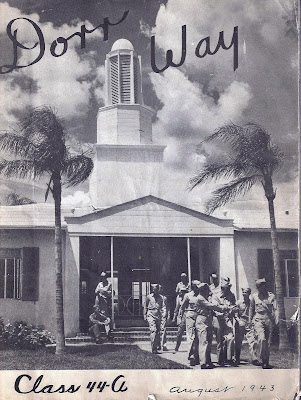 |
| 2013 Some things of my father, insignia, leather pilot cap |
This photo of my father at the propeller is 1943 with him wearing this or another identical cap at Dorr Field, Arcadia Florida during his early flight training in P-38's and PT's.
 |
| 1943 July Lt L S Ball Dorr Field |
This is the cover of my father's August 1943 "Dorr Way", a booklet for the pilot trainees, they were the class 44-a. I am mindful of the task these men faced and grateful that I have these historic items. It is a wonder that in the times of WWII the U S Army Air Corp would take the time to photograph and document their times at these different training sites. It was a time when they would move quickly through and advance to the next training or wash out and be assigned to another task, not able to make it as a pilot. Many hundreds of thousands of men went through the training but most did not achieve pilot status. The wash out rate was at it lowest 30 percent but in later years 45%; but the men who were not pilots would be given other flight status jobs, bombardier, gunner, radioman, all with an appreciation of the difficulties they faced.
I cropped and enlarged the photo to the right of my father from the Squadron photo. There again is that aviator cap, and goggles. He looks happy and excited. Look at his sparkling smile and his eyes. He had less than one year of life left ahead when this photo was taken. Maybe he did not yet know that the Liberator awaited. He was a positive young man. Lou would confide in his young brother, Henry, on his final leave home that he was not so sure he had done the right thing in taking the pilot's training. I doubt if he had much choice, he was in the Army and they made the rules. It was not today's Army by a long shot and how could he have declined pilot training for which he scored very high in aptitude and preliminary screenings. The aviators gathered in the photo below are waiting solo assignments.
This is my Sepia Saturday contribution. Click here to the Sepia host site where members of the international community respond to the prompt. This week many consider the eyes in the photo.
http://sepiasaturday.blogspot.com/2013/05/sepia-saturday-178-25-may-2013.html
Louis Zamperini discusses the huge fatality rate of B-24 crew in his marvelous book , "Unbroken" authored by Laura Hillenbrand, the dangers that abounded even before they flew off to war theater. The men called the B-24 "The Flying Coffin" "Stories of its dangers circulated among the would be airmen all over the country. Pilot and navigator error, mechanical failure, fuel leakages, sinkability, inability to ditch, and bad luck were killing trainees at stunning rate.. 52,615Army Air Corps stateside aircraft accidents over WWII killing 14, 903 personnel...In August 1943 590 airmen would die stateside, 19 per day."
 |
| My father's squadron, # 6 at Dorr that Class of 44-a. There were 6 similar squadrons according to this book. He is seated to the far right on the ground. |
I cropped and enlarged the photo to the right of my father from the Squadron photo. There again is that aviator cap, and goggles. He looks happy and excited. Look at his sparkling smile and his eyes. He had less than one year of life left ahead when this photo was taken. Maybe he did not yet know that the Liberator awaited. He was a positive young man. Lou would confide in his young brother, Henry, on his final leave home that he was not so sure he had done the right thing in taking the pilot's training. I doubt if he had much choice, he was in the Army and they made the rules. It was not today's Army by a long shot and how could he have declined pilot training for which he scored very high in aptitude and preliminary screenings. The aviators gathered in the photo below are waiting solo assignments.
 |
| 1944 June, short newspaper clipping about disappearance of my father and ..Combat crew 193 |
| Last photo Dorr Field book 1943, an almost spooky quality to the men now ready to meet their destiny, whether to the next phase of training as in Lou's case or...,. |
This is my Sepia Saturday contribution. Click here to the Sepia host site where members of the international community respond to the prompt. This week many consider the eyes in the photo.
http://sepiasaturday.blogspot.com/2013/05/sepia-saturday-178-25-may-2013.html






